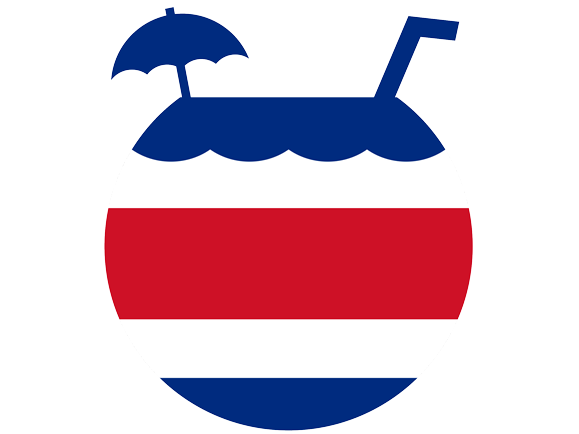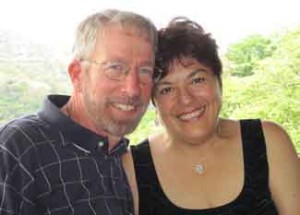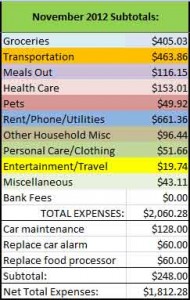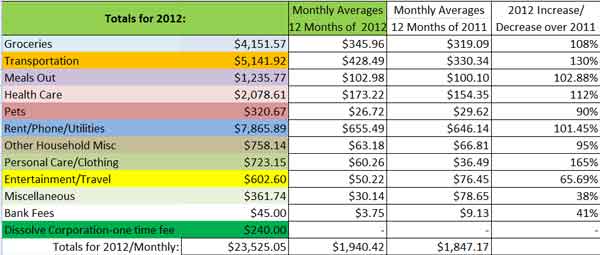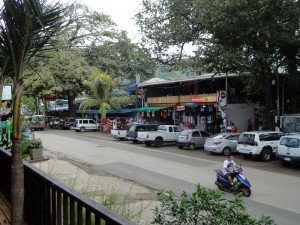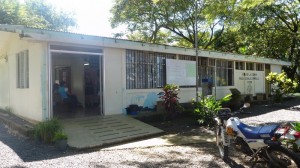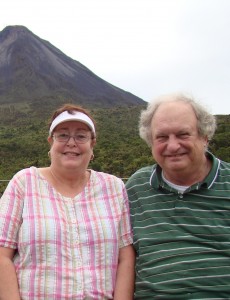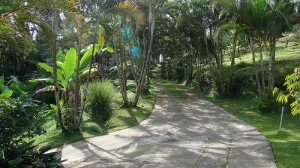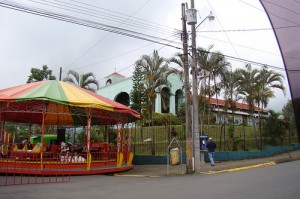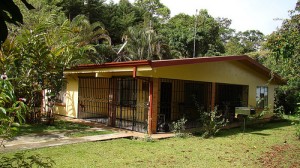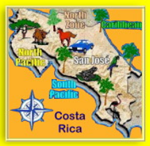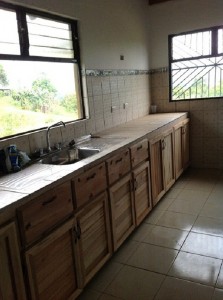Cost of Living
Newsletter – Cost of Living Issue – January 22, 2013
In This Issue:
- Our December 2012 Budget
- Our 2012 Cost of Living Summary
- So What Would It Cost ME to Live in Costa Rica?
- MythBusters: What’s it REALLY Like to Live in Costa Rica?? by Tom Duffy
- Reflections on Five Years Living in Costa Rica, by Connie Sandlin
- Time to Trim the Banana Plants! – Video
- Types of Costa Rica Residencies, Requirements, and Benefits
- Date Announced for iPad Digital Art Workshop
- Featured Real Estate — Newly Renovated Property in Nuevo Arenal-REDUCED to $130K
Our December 2012 Budget
December is usually an odd month budget-wise. There’s Christmas, of course, and Gloria’s birthday. And this year we also had our move from the Cabinas to our rental house. Plus, there is the yearly Marchamo due on our car. Surprisingly though, we had a very good December in terms of our spending. Here’s how it breaks down:
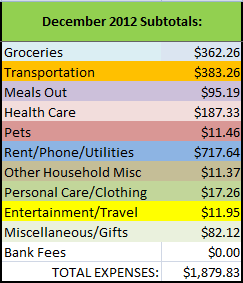 Groceries were a bit higher due to buying supplies for all the Christmas cookies I baked. Mmmm…double-chocolate biscotti.
Groceries were a bit higher due to buying supplies for all the Christmas cookies I baked. Mmmm…double-chocolate biscotti.
Transportation was higher due to payment of the Marchamo for our 4-Runner. Marchamo is Costa Rica’s annual registration and mandatory car insurance. Our’s this year was the equivalent of $186.80…a bit higher than last year, even though our car is one year older (and, you would think, worth less than last year).
Our rent/phone/utilities category was also higher since we paid some of the utilities at our new rental house, specifically propane for the hot water and stove, and the monitoring on the security system. We’ll have a full break-down of this category next month when we’ve paid a round of all of the new expenses.
All-in-all, we are quite pleased with our December spending of $1,879.83. You can see it’s pretty close to our spending for the previous two months. In the following article, we look at how it stacks up to the rest of the year’s spending.
Related Articles:
Our 2012 Cost of Living Summary
If you like numbers, you’ll like this article.
The results are in. In 2012, after almost 4 years in Costa Rica, we were still able to live on less than $2,000/month, for a total of $23,525.05/year.
While we spent $1097.69 more in 2012 than we spent in 2011, we still come in under the 5% adjustment for inflation, which has been the norm for Costa Rica in recent years.
Our grocery bill went up 8% in 2012, attributed to increased food costs. We actually spent less in high-end stores like Auto Mercado and Pricesmart and bought more locally.
The 30% increase in transportation spending is mostly due to an accident in February 2012 that required $1,100 of body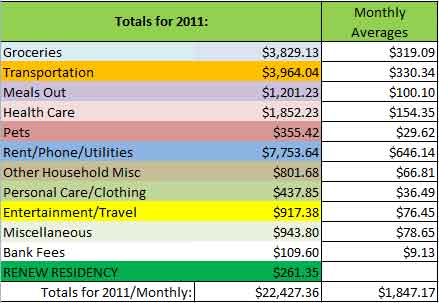 work to repair. Without that, there actually would have been a small percentage savings over 2011.
work to repair. Without that, there actually would have been a small percentage savings over 2011.
Bank fees went way down. Our system of writing a check to our account in Costa Rica, then converting it to colones and spending it down over a couple of months has been working well. Since we rarely need to withdraw money from our U.S. checking account, we rarely have to pay the $8/transaction fees at the ATM. $5.00 of that is assessed by Bank of America in the U.S., and the other $1.50 to $3.00 is on the Costa Rica end for using an out-of-country ATM card from a non-affiliated bank.
We paid 12% more for health care in 2012. Not sure why exactly. Maybe it’s because of all the shots and pain medication (just an anti-inflammatory/antioxidant combo) I’ve been taking for my sciatica. Our monthly Caja (Costa Rica’s national health care program) bill did go up by 23%, but that didn’t happen until late in the year. Still, we think that just over $2,000 for health care for the whole year is great. That includes medical, dental, Caja, any tests and lab work not covered under the Caja, pharmacy, and even vitamin supplements from the macrobiotica (health food store).
We spent 65% less on travel and entertainment than we did the previous year. Guess we’ve just been more content to stay home. But we sure haven’t suffered for it. On the other hand, we spent 65% more on personal care and clothing. Some things finally had to be replaced, plus Paul needed a new pair of eyeglasses.
Related Articles:
- Our 2012 Annual Cost of Living Update-First Six Months
- Update on Our Cost of Living in Costa Rica (May 2011)
- Paul’s Monthly Tip to Live for Less in Costa Rica: Buy Local
- Paul’s Monthly Tip to Live for Less in Costa Rica: Shop at Ropa Americana
 So What Would It Cost ME to Live in Costa Rica?
So What Would It Cost ME to Live in Costa Rica?
by Paul
Well, the realistic and safe answer is, “it all depends on you, on your lifestyle and how you want to live.” People have asked us the question, “Can we live on $3,000-$4,000 per month? In response, Gloria and I look at each other, chuckle, and say, “Of course you can.” Again, it all depends on how you choose to live. We manage to save over 30% of our U.S. monthly budget and we think we live pretty well. If we followed more of our own tips, we could possibly further reduce our expenditures. Our goal is to live on less than $2,000 per month, and that has been easily achievable. But if you want to live in an expensive home (either a rental or to purchase) and shop exclusively in the “American” stores (Auto Mercado and Pricesmart), it can actually cost you more than in the U.S. If you purchase an expensive car and are looking to live in luxury, than that $3,000 target may not be achievable.
First, let’s look at our previous “big three” monthly expenses: 
- Healthcare was over $1,000, now $175/month
- Rent or mortgage was $1260, now $500/month
- Heat and air-conditioning was $250, now $0/month
Other areas of savings for us include:
- Groceries
- Eating out
- Telephone
- Car insurance
- Transportation
- Clothing
- Entertainment
- Pet care
Look at our budget totals for the last three months. You can see that our car expenses are a big chunk of our monthly living expenses. If you choose not to buy a car, and take public transportation instead, think about how much you could save.
Often people will say they wouldn’t want to do that, you HAVE to have a car. It’s just not true. I know more than a few people who don’t have cars. It simplifies their lives greatly and saves them money. They walk, take buses and taxis. It’s the one thing you can do to easily simplify your life and cut expenses. But remember, without a car, you’ll do less, ergo spend less. You can always try going without a car for six months and buy a car later if you so desire.
Another way to keep your budget down is to rent a house or apartment for $300-$700 per month. Two of our expat friends moved into in a small two bedroom apartment in town. It’s unfurnished, clean but cute, and they are paying $300/month rent, plus utilities. Since they live right in the town of San Ramon, and don’t own a car, their transportation costs are about $20/month. They walk a lot, take buses and taxis. Living in town, they are also immersed in the culture, have a lot of Tico friends, and speak a lot of Spanish which helps them to learn the language. They may not have that big view that we expats like, but everything’s a trade-off.
It’s not just about saving money. It’s that fact that when you own less, and need less, life is more simple and stress free. It’s all about your choices.
Related Articles:
- Paul’s Monthly Tip to Live for Less in Costa Rica: Don’t Buy a Car
- Paul’s Monthly Tip to Live for Less in Costa Rica: Taking the Bus
- Why We Chose Costa Rica
- Our Retire for Less in Costa Rica Philosophy
- Less is More
- Raising Your Standard of Living
- Simplicity – What is It?
 MythBusters: What’s it REALLY Like to Live in Costa Rica??
MythBusters: What’s it REALLY Like to Live in Costa Rica??
by Tom Duffy
The Duffys currently live in Chantilly, Virginia, in the U.S. and are planning their move to Costa Rica in the near future.
When Dina and I starting researching moving to Costa Rica we found many conflicting opinions and comments about living in Costa Rica. In the past year we have taken two due diligence tours to Costa Rica. These trips enabled us to either verify or dispel what the “experts” were saying on the internet. In most cases we were surprised that most of what the naysayers claimed was not true. Here are some of our findings.
Some back roads in remote areas are very rough and require 4×4 vehicles to maneuver through these areas. Certainly in the rainy season roads are not as good as they are in the dry season, but most are passable when using caution and common sense. However most roads are decent and some are very good, such as the new Caldera Highway. I suggest using GPS when travelling around Costa Rica.
Myth: There is a lot of crime.
We felt safe everywhere we went in Costa Rica. That included travelling in San Jose, the Central Valley and the beaches of Guanacaste. Just like travelling anywhere, whether in a foreign country or the U.S., don’t be careless and do stupid things. For instance, don’t leave valuables in your car in plain sight. This is true in Costa Rica as much as many cities in the U.S. However we have found most of the Ticos we met were friendly and helpful to us.
Myth: You have to give up lots of food choices when you move there.
That depends on where you live. If you live in the Central Valley you will have many more choices than if you live at the beaches. We already found places to get U.S. products, such as Pricesmart or Auto Mercado. We also found people and/or places that offer quality meats, cheeses and good prices on alcohol products. Be aware these products will cost more than in the U.S., but at least you can get them if you really need them. It is important to network with the Expat community to find out what is available and where they are located.
Myth: The food in Costa Rica is not very good.
We dined at some very good restaurants in Costa Rica and had some terrific meals. We had some of the best Chinese meals ever in San Jose, and a really great fish dish in Atenas. We also had some wonderful local Tico food (gallo pinto) at sodas (small family-run restaurants). It was very good and very cheap.
Myth: It is very expensive to live in Costa Rica.
It is true that Costa Rica is not the cheapest country in Central America. However it is far cheaper that living in the U.S. Prices are going up all over the world and Costa Rica is no exception. Many people comment on forums about the cheaper prices on products in the U.S., but most of these comments are based on years-old data. If you currently live in the U.S. or recently left, you will know how much prices have risen recently. It also depends where you live in Costa Rica and how you live. You can find a wide range of prices in rentals as well as property prices. That’s why it’s difficult to make an overall statement on expenses. The answer is “it all depends.”
Myth: Appliances are prohibitively expensive.
The U.S. brands are more expensive, but prices are coming down because of more demand and CAFTA. You can also visit the duty-free zone of Golfito and purchase these products at very good prices. You can also buy used items on Craigslist from Expats who are moving back home.
Myth: Banks always have long lines and you have long waits.
Again, it depends. National banks will be busier than private banks and private banks are generally more efficient. Banks will be busier at certain times of the day, such as around noon, and at times of the month, for instance when Social Security checks come in. From our own experience, we had no problems. There are also ATM’s readily available.
Myth: The Government is slow and inefficient.
This is true! You just have to get used to it and not stress out or compare it to the U.S.
If you are going to a government facility, bring a book, a kindle, a tablet or a crossword book to pass the time. Be prepared to wait. On our last trip to Costa Rica we obtained our Driver’s licenses. It took us 5 hours to go through the process. We expected to take about 2-3 hours, but we made the best of it by talking with others and inwardly laughing at the absurdness of the process…Pura Vida!
Local Feria (farmers’ market)
In closing, I would like to add that if you are considering moving to Costa Rica, then you must travel there, not as a tourist, but as a future resident and investigate for yourself.
There are numerous companies that offer “due diligence” tours which are very helpful and give you a good baseline of information. It is imperative that you do this. You cannot make a drastic life changing move by simply sitting at your computer and gathering information (much of which is inaccurate). You must go there yourselves and explore and find out the answers for yourself. It will be worth it, and you will have a great time in the process!
Related Articles:
- The Good, the Bad & the Ugly: The Truth About Crime in Costa Rica
- Crime in Costa Rica
- Renewing our Costa Rica Drivers’ Licenses
- Retire in Costa Rica on Social Security!
Reflections on Five Years Living in Costa Rica
by Connie Sandlin
After visiting Costa Rica several times since 2006, Connie and Dick Sandlin made the move to try living here for 2 ½ months in mid-May 2008…and they never looked back. The March before their move, they wrote an email to family and friends to share their big news. Now, nearly 5 years later, they’ve revisited this email to examine how reality stacks up to their expectations at the time. Thanks to them both for allowing us to reprint this in our newsletter. Their 2008 email contents are in normal text and the follow-up comments 5 years later in December 2012 are in bold italics.
Dick and I will be spending part of the summer in Costa Rica. This summer stay will be a ‘tryout’ in anticipation of a possible move. We’ve been asked: “So, why are you considering moving to Costa Rica?”
The cost of living and medical care have a lot to do with it. It’s much, much cheaper to live in Costa Rica, and in fact it’s possible to live well on income from Social Security alone (depending on one’s idea of living “well”. The cost of everything is going up here, as it is pretty much everywhere.) Currently, private pay horrible health care insurance and prescription costs are eating us alive (Blue Cross Blue Shield-Texas Health Risk Pool and no dental). Dick’s not going to be old enough for Medicare for 2 1/2 more years and I’m several years behind him. (Dick is now old enough for Medicare but we declined Part B, avoiding a chunk being taken out of his monthly check.)
We will apply for, and hopefully obtain, ‘pensionado‘ residency status. (This will not involve losing our US citizenship. Many are surprised to learn that you can now hold dual or triple citizenships while still being a US citizen.) When we get residency status, we’ll be eligible to apply for the national health insurance, which will cost us about $31 a month for BOTH of us, instead of $1500 a month. Even if we choose to pay privately in Costa Rica from time to time, it will cost us maybe 1/8 to 1/6 of what health care costs in the USA. Utilities in Costa Rica typically cost about $25 per month. (Having done my homework/due diligence, I had all our paperwork duly notarized and in hand when we arrived in Puriscal on May 15, 2008. We met with the residency attorney two weeks later and initiated the process. Once we were notified that we were being approved, we applied for participation in the national health care system (nicknamed the CAJA) and now pay monthly premiums of about $68 that cover both of us for virtually everything – doctor visits, prophylactic dentistry, prescriptions, lab work, emergency care, etc., etc., with NO co-pays and NO deductibles).
But there are many, many more reasons:
- The Costa Rican people are kind and gentle. They look you in the eye and say ¡Buenas! or ¡Hola! I like that. If we behave that way in the city these days, we’re considered a little odd. There, if you don’t stop and socialize at little, you’d be a little odd, or considered ‘stand-offish’. (Ticos are still friendly and extremely helpful. I love that!)
Nature is abundant and generous. The Ticos (as Costa Ricans call themselves) cut branches off trees at the new moon and push them in the ground. Due to abundant rain, the sticks start growing into trees within 2 weeks. One papaya tree that was pointed out to us had come up on its own a year before and grew 40 feet in one year. Fresh fruit is plentiful and cheap, and the Tico diet is very healthy. (Still true, but more American fast food chains are encroaching here.)
- IT IS BEAUTIFUL…’PARADISE ON EARTH’ BEAUTIFUL (Still true.)
- The country is 92% Christian (75% Roman Catholic). (Still true and very suited to our beliefs. Attending Mass in our community has really helped us be assimilated.)
- The longevity rate is one of the highest in the world. (Still true.)
- Ticos are relaxed in their lives and dislike confrontation. I want some of that to rub off on us, especially me. (Dick’s much nicer than I am.) Dick and I are still very much in love after 36 [40] years, but we bicker too much, even so. I want a chance to immerse myself in a culture that isn’t so anxious and rushed, and allow it to smooth out some of my rough edges, to make me kinder and gentler, and less afraid of people. (I have shyness and fear issues.) (We bicker less and are more relaxed. I think living here is improving my character and I am less shy and fearful than I used to be. I have also been working on being more hospitable and usually, but not always, succeed in that, too.)
- The literacy rate is one of the highest in the world. (Still true. I find Ticos to be very well informed, but a big difference in cultures is that most Ticos are not avid readers in the way that many North Americans are.)
- Costa Rica is politically neutral, like Switzerland, and has no standing army. Instead of spending money on military, money is put into health care and education. (Still true but some money gets wasted either through inefficiencies or, sometimes, corruption. But nobody’s aiming terrorist threats at Costa Rica, THANK GOD.)
- The gringos/expatriates who already live there are very welcoming to others coming to try the Costa Rican life. I’ve already been offered good advice and referrals for great physicians. And a lot of the gringos seem to come from Dallas/the Metroplex. (By the way, ‘gringos’ is not a pejorative term in Costa Rica.) (Well, some Ticos have told me that “gringos” is less polite than “norteamericanos” (North Americans). Also, we have both Gringo and Tico friends here.)
- The country is the approximate size of West Virginia, with much of it being mountainous. (Still true – not flat like Dallas!)
- Even though it’s close to the equator (between 9 to 11 degrees north of the equator), it’s possible to find microclimates to almost anyone’s taste – just go higher or lower on the mountainside. Much of the country experiences perpetual spring temperatures in the 70s. If you like it hot, just go to the beach – Pacific or Caribbean. (Our temperatures are usually in the 60s-70s, occasionally up into the 80s briefly. We neither have nor need air conditioning nor heating.)
25% of the country is set aside for national parks/nature preserves. (Still true.)
- Birds, birds, birds, birds, birds, butterflies, orchids, birds, flowering trees, bromeliads, birds, frogs, interesting insects, birds, rainbows, clear springs, volcanoes, mountains, rain forest, birds, birds, and did I mention birds? (Birding and being members of the Birding Club of Costa Rica has taken us to parts of Costa Rica we might not otherwise have visited.)
- I studied Spanish for 3 years in high school and I minored in Spanish at UT Arlington. I planned to live in Guanajuato, Mexico for the summer of 1972 to become very fluent, but instead I married Dick that summer. Now, I can really get intensive Spanish experience! (I think learning Spanish will be very easy for Dick because of his linguistic aptitude. Ask him about the Air Force sending him to Russian language school in the 60s, if you don’t already know about his languages.) I found on our last trip that the Ticos like to speak English (and learn from me) and were gracious in helping me with my Spanish. They’d speak English, and I’d speak Spanish. It was win-win. (My Spanish is improving to the point where sometimes I’d rather speak Spanish than English to express myself and Dick’s Spanish continues to come along. I’m finally getting my ‘foreign exchange’ experience!)
- I think all the new things we’ll learn, people we’ll meet, and the challenges we’ll encounter will stimulate our minds. (Yes, our minds and souls are being stimulated, which is good exercise for older brains!)
- Our kids are grown and married, we don’t have any grandchildren yet (and don’t expect any for a couple of years or so), we have very little debt, and we still have some savings that haven’t hemorrhaged completely away due to medical costs quite yet. (Some changes here, but we made the move at the right time.)
The downsides:
- Missing our relatives, friends, and St. Francis family – HUGE. (Still true.)
- Culture shock. (Has mostly been overcome for us.)
- Driving can be hazardous. (Still true, but we’ve adapted.)
- You can’t drive very fast due to low speed limits and winding roads (a downside for Dick, just great with me.) (Still true and I love it.)
- Starting virtually from scratch. (Actually, this was an upside – leaving our “baggage” behind, mostly.)
- The work to just get it all together, if we actually move. (We did it.)
After our tryout, if we decide to live in Costa Rica, at least for a while, our plan is to have a rental agent handle the leasing of our home, providing us income and a place to come back to. We don’t anticipate selling our home here, but that is a future possibility. (We would like to sell our home on Bowman Blvd if we can get the price we need and buy this house here, hopefully in 2013.) And we plan to find a place big enough to have guests! (And we do have a place that’s big enough for guests – 2 guest rooms!)
So, there it is. That’s why we did it and how it’s turned out up to now. Pulling up stakes suddenly and moving to another country is not for everyone, even if it is to Costa Rica, but it’s worked out GREAT for us!
Related Articles:
- Paul’s Monthly Tip to Live for Less in Costa Rica: Speak Spanish – Save Money
- Book Excerpt 1 from Butterfly in the City
- Paul’s Monthly Tip to Live for Less in Costa Rica: Join the Caja, Costa Rica’s National Medical System
- Enjoying the Life
Time to Trim the Banana Plants!
In December and January, Costa Rica can be a very breezy place. The wind can shred the broad green leaves of banana plants into fringes. And whether it’s windy or not, leaves die and turn brown all year round. So every three or four months, our gardener trims the banana plants to neaten them up. Right now we have about 10 huge bunches of bananas growing on the plants surrounding our house. We’re just waiting for them to ripen and the monkeys to discover them!
 Types of Costa Rica Residencies, Requirements, and Benefits
Types of Costa Rica Residencies, Requirements, and Benefits
Originally published by the Costa Rican Times, December 2, 2013
Costa Rica News – There are many people that are thinking about applying for Costa Rican residency. Getting residency can make life in Costa Rica a little more easy to deal with and get rid of some of the red tape that you have to go through on a day to day day basis for non-residents including the 90 day trip leaving the country for perpetual tourists.
- PENSIONADO (Retiree)
- REQUIRES: Must show proof of monthly income from a qualified pension plan of at least $1,000 USD per month.
- STAY: Must remain in the country at least 4 months (121 days) per year and these days do not have to be lived in the country consecutively.
- FAMILY: Only one monthly pension is needed with married couples.
- NOTE: The resident can apply for permanent residency after being a temporary resident for three (3) years.
- RENTISTA (Renter)
- REQUIRES: Proof of income of $2,500 USD, regardless of civil status or number of dependents, as well as proof that the $2,500 monthly payment to the applicant is guaranteed for the next 60 months (5 years).
- STAY: Must remain in the country at least 4 months (121 days) per year and, do not have to be lived in the country consecutively.
- FAMILY: Can claim spouse and dependents under 18 years of age.
- BUSINESS: Can own a company and receive income.
- REPRESENTANTE (Representative)
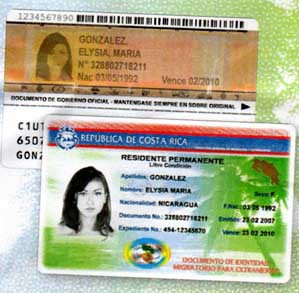
- >REQUIRES: The applicant should be a director of a company with certain requirements, such as employing a minimum number of local workers as established by the labor law, with financial statements certified by a Public Accountant.
- STAY: Must remain in the country at least 6 months per year.
- FAMILY: Cannot claim spouse and dependents under 18 years of age. It must be a separate process.
- WORK: Can earn an income from the company.
- BUSINESS: Can own a company and receive income.
- PERMANENTE (Permanent)
- REQUIRES: A first degree relative status with a Costa Rican Citizen. Married to a citizen does not make you eligible for permanent residency, however, you may obtain temporary residency for 3 years, renewable every 3 years with proff of a conjugal relationship, or one may apply after 3 years in another residency type.
- STAY: Must visit the country (Costa Rica) at least once a year.
- FAMILY: Cannot claim spouse and dependents under 18 years of age.
- BUSINESS: Can work as an employee, own a company, and receive income.
- INVERSIONISTA (Investor)
- REQUIRES: Investment of at least $200,000 USD in any business or a specified amount of investment in certain government approved sectors.
- STAY: Must remain in the country at least 6 months (183 days) per year. and these days do not have to be consecutive.
- FAMILY: Cannot claim spouse and dependents under 18 years of age. It must be a separate process.
Please note that there are additional requirements to qualify for each of these residency categories, and in particular for applications under the Inversionista (investor) Program.
Once you know you qualify, your attorney can take it from there (make sure you find one you trust). This may require several trips to the Immigration office in San Jose or simply signing documents as they come. As with most things in Costa Rica, the paperwork will take a while, so be patient. While in the process of applying for residency, you are safe to be in the country as long as you carry proof of application for residency with you.
Related Articles:
- Link to original article: http://www.costaricantimes.com/types-of-costa-rica-residencies-requirements-and-benefits/8486
- For trusted help with legal residency in Costa Rica, contact Residency in Costa Rica
- Investing and Residency
 Date Announced for iPad Digital Art Workshop – Wednesday, February 27, 2013 in San Ramon
Date Announced for iPad Digital Art Workshop – Wednesday, February 27, 2013 in San Ramon
 Whether you are an artist, or simply have an iPad and a desire to learn to use it as a tool to express yourself artistically, this is the workshop for you!
Whether you are an artist, or simply have an iPad and a desire to learn to use it as a tool to express yourself artistically, this is the workshop for you!
- Where: In San Ramon, directions will be forwarded upon registration and payment
- When: Wednesday, February 27, 2013
- Cost: Only $80 for the full day workshop, including lunch.
Digital artist, Mandy McMahan, leads the class in interactive, step-by-step approaches and makes using the iPad technologically approachable, intellectually stimulating, and fun.
Using the iPad as a mobile art studio, participants will create their own digital fine art works using a combination of up to 6 drawing and painting apps.
 Using your iPad as a mobile art studio you will:
Using your iPad as a mobile art studio you will:
- create your own unique fine art, collage and photo altered pieces.
- use iPad painting and drawing apps both individually and in tandem
- navigate through importing and exporting source material.
- learn methods for sharing your art on the internet.
- learn how to take your art from your iPad to your wall.
All ages welcome. Materials: Any model iPad; an iTunes account and knowledge of downloading apps.
If you are interested in more details about this workshop, please contact us at info@retireforlessincostarica.com.
Sharing tools, techniques and approaches for the creation of beautiful art is one of the most satisfying things I can do in this lifetime.”
Mandy McMahan
A few words from Jim White:
Hi, I am Mandy’s partner and husband. I am truly excited about assisting Mandy with her iPad Art workshops.
I have been in the training and personal development business for 38 years and have worked in about 18 countries in designing and facilitating workshops and seminars focused on personal growth, leadership development and skills acquisition.
Without bias, when Mandy conducted her first iPad workshops, I was truly amazed at her technical mastery, warm teaching presence and her ability to make the iPad fully accessible. The students left the class having confidently created beautiful and satisfying fine art pieces.
Please join us for a fun few hours where you will take your artistic skills to the next level-digitally.
To learn more about Mandy and to see more of her art, visit her website, Mandy’s Digital Art Place.
 Featured Real Estate — Newly Renovated Property in Nuevo Arenal-REDUCED to $130K
Featured Real Estate — Newly Renovated Property in Nuevo Arenal-REDUCED to $130K
Reference# Res-36
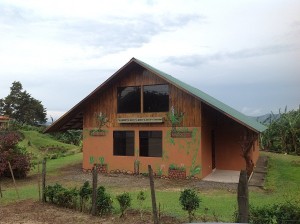 Price: $130,000, reduced from $150,000
Price: $130,000, reduced from $150,000
3 brm. Chalet-style home in residential area, with Lake view
This newly renovated home sits on one acre of property in an area with many ex-pats. It is 3 miles from the growing town of Nuevo Arenal which is popular with foreigners who want to live a comfortable and healthy lifestyle.
There are many good restaurants and services with friendly Ticos who are proud of this town and its many beautiful homes.and gardens.
This chalet has teak wood interiors and a beautiful view of Lake Arenal. A patio and 2nd floor terrace could easily be added to back for BBQs and viewing lake and volcano.
Owner will accept 50% down and 2 years to pay balance at 6% interest.
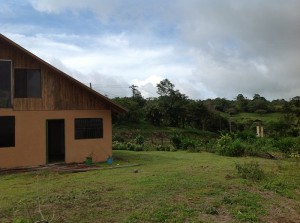
Click here for more photos and to contact the realtor for this property.
Click here to check out our other properties under $150,000 and read about what to do before you buy.
Related Articles:
Facebook, Twitter, & YouTube
![]()
![]()
![]() You can now follow us on Facebook and Twitter, so please “like” us on Facebook, “follow” us on Twitter, and watch and share our videos on YouTube.
You can now follow us on Facebook and Twitter, so please “like” us on Facebook, “follow” us on Twitter, and watch and share our videos on YouTube.
What’s New on the Website
Check out our newest posts on www.retireforlessincostarica.com:
- Healthcare in Costa Rica—Our Recent Experiences
- Moving On: Part III—Settling In and Coming Full-Circle
- Paul’s Monthly Tip to Live for Less in Costa Rica: Buy Just What You Need
- CPI’s New Online Spanish Classes
- Paul’s New Year’s Resolution: Don’t Get the Gardener Mad!
- Update: America’s No Place to Get Old In
- Update: Bugs in Costa Rica
- Moving On: Part I
- Moving On: Part II — Change is Hard. Really.
